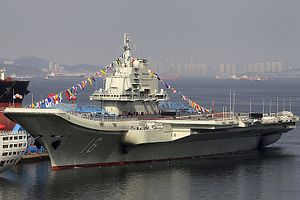The Liaoning, China’s first aircraft carrier, recently completed its first live-fire exercises before sailing from the Bohai Sea to Hainan Island. Additionally, its first indigenous aircraft carrier, the Type 001A, is under construction at Dalian shipyard and should be completed in the first half of 2017. In 2015, Taiwan’s Ministry of National Defense reported that a third aircraft carrier is being built in Shanghai. These ships will add a new capability to the People’s Liberation Army Navy (PLAN), but the threat they pose should be kept in perspective. China’s aircraft carriers will affect the balance of power in East Asia, but local states have ways to mitigate the impact and maintain deterrence.
China’s rapid carrier buildup represents a major change in its naval acquisition policy. In a 2015 Washington Quarterly article, Yu-Ming Liou, Paul Musgrave, and J. Furman Daniel III point out:
For the past several decades, [PLAN] acquisitions had focused not on matching the U.S. Navy force structure, but rather on countering U.S. strengths with asymmetric capabilities.
Indeed, several new Chinese weapons systems have been called “carrier killers,” including the DF-21D anti-ship ballistic missile, and the Type 052D destroyer armed with YJ-18A anti-ship cruise missiles. These and other so-called anti-access/area denial (A2/AD) systems represent the Chinese military’s comparative advantage vis-à-vis the United States, which makes the recent large investment in aircraft carriers somewhat puzzling.
The primary military benefit of aircraft carriers derives from their ability to project airpower far from China’s territory. However, the Liaoning and the first of China’s two indigenous aircraft carriers weigh in at around 60,000 tons compared to the 100,000 tons of America’s Nimitz-class carriers. This smaller size means a smaller air wing for the Liaoning, and the lack of a catapult system on the Chinese carrier means that aircraft will have to carry a lighter weapons load in order to take off.
Additionally, in order to significantly expand China’s defense envelope the Liaoning must leave the protective umbrella created by China’s land-based A2/AD systems. Operating as a carrier strike group with other PLAN warships would provide a degree of protection, but this would amount to a relatively small increase in range for a significant increase in vulnerability. For the time being, the military benefit of the Liaoning and her successors will be relatively limited. The PLAN will gain some operational flexibility in naval warfare, but this gain will be offset by the carrier’s technical limitations and increased vulnerability as it sails further from China’s shores.
While the Liaoning and its successors wouldn’t extend China’s reach too significantly, they could target Taiwan while remaining comfortably inside China’s A2/AD zone. Taiwanese military officials were vocal about the threat posed by the aircraft carrier during its voyage across the western Pacific. The best way for Taiwan to defend against this threat is to adopt the same kinds of A2/AD capabilities that China uses against U.S. aircraft carriers.
Some of these capabilities already exist in Taiwan’s armed forces. In late 2014, Taiwan’s navy received its first Tuo Chiang corvette. The 500-ton boat carries eight HF-3 anti-ship missiles, which have also been dubbed “carrier killers.” The Tuo Chiang is not without shortcomings. It lacks an air defense capability and it cannot detect targets at very long range without help from other systems. But the existence of the Tuo Chiang and similar weapons systems indicate that Taiwan is thinking about an asymmetric response to China’s growing carrier force.
In order to defend against China’s aircraft carriers, other states should follow Taiwan’s lead and invest in weapons technology that exploit the range limitations of Chinese carriers to further limit the PLAN’s freedom of movement in the western Pacific. Other states will have a good amount of time to build and field such forces given the amount of training time required to master the complexities of carrier operations, but the sooner they make the investments the better. The Liaoning is an improvement for the PLAN and should be taken seriously, but China’s experience with A2/AD shows that there are ways to threaten aircraft carriers at a reasonable cost.
China’s investment in aircraft carriers will take a great deal of time and money to reach its full potential. Aircraft carriers are a potent symbol of military power, but they have vulnerabilities that can be exploited. China has provided a “how-to” guide for countering aircraft carriers that should be emulated. Diverting resources from its comparative A2/AD advantage is a gamble for China. U.S. allies should place their bets on their own A2/AD capabilities.
Eric Gomez is a policy analyst at the Cato Institute.

































